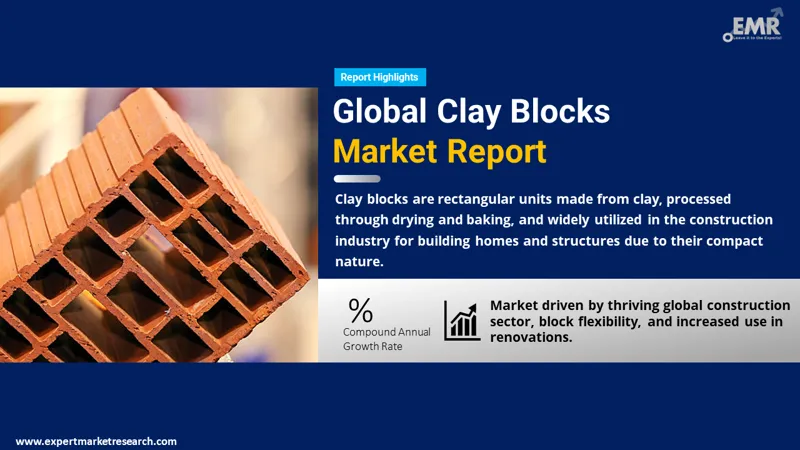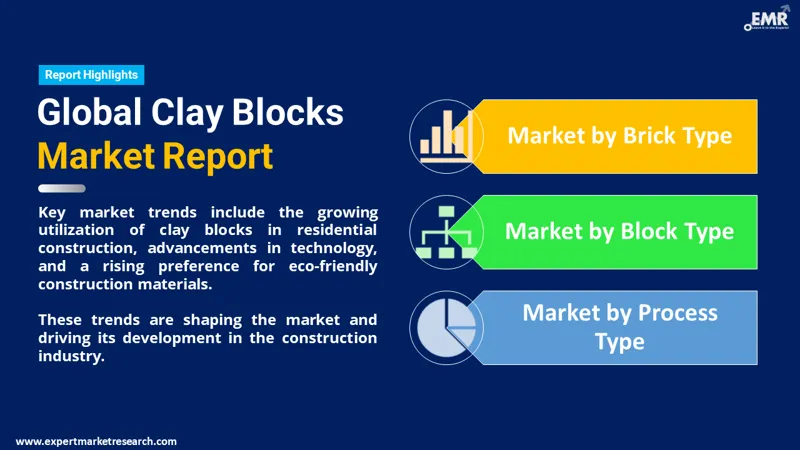
Consumer Insights
Uncover trends and behaviors shaping consumer choices today
Procurement Insights
Optimize your sourcing strategy with key market data
Industry Stats
Stay ahead with the latest trends and market analysis.
The global clay blocks market size reached a value of approximately USD 6.03 Billion in 2025. The market is further expected to grow at a CAGR of 6.30% between 2026 and 2035, reaching a value of USD 11.11 Billion by 2035.
Base Year
Historical Period
Forecast Period
Compound Annual Growth Rate
6.3%
Value in USD Billion
2026-2035
*this image is indicative*
Clay blocks are rectangular shaped blocks that are made of clay, through a drying and baking process, to create compact units that are commonly used in the construction sector for the building of homes and buildings. They are considered natural and green products, are lightweight, cost-effective, and offer thermal insulation, sound insulation, high compressive strength, and a long lifespan.

Read more about this report - REQUEST FREE SAMPLE COPY IN PDF
The EMR’s report titled “Clay Blocks Market Report and Forecast 2026-2035" offers a detailed analysis of the market based on the following segments:
Market Breakup by Brick Type
Market Breakup by Block Type
Market Breakup by Process Type
Market Breakup by Region

Read more about this report - REQUEST FREE SAMPLE COPY IN PDF
Fly ash bricks, on the basis of brick type, account for a healthy share of the clay blocks market as they are lighter in weight and lower in cost than clay bricks. The raw materials for fly ash bricks are sourced from waste materials of thermal power plants that are generated during the combustion of coal. As a result, there is an extensive supply of low cost raw materials available to produce fly ash bricks, which are increasing their market share. Fly ash bricks are also higher load bearing, have greater compressive strength, and high tolerance for dimensional stability, further increasing their cost-effectiveness and suitability in construction applications.
The Asia Pacific occupies a sizable share of the global clay blocks market, driven by the growing construction industry, especially in countries such as India and China. Significant investments in infrastructure development in the Asia Pacific region and the advantages offered by clay blocks are augmenting their usage in the region, and contributing to the growth of the overall market. Meanwhile, North America is anticipated to witness steady growth in the market for clay blocks due to increasing renovation activities and growing preference for green building and construction materials.
The comprehensive EMR report provides an in-depth assessment of the market based on the Porter's five forces model along with giving a SWOT analysis. The report gives a detailed analysis of the following key players in the global clay blocks market, covering their competitive landscape and latest developments like mergers, acquisitions, investments, and expansion plans.
Wienerberger AG is an Austrian manufacturer of bricks which was founded in 1819 and is headquartered in Vienna, Austria. They specialise in clay roof tiles and manufactures pipe systems, producing high-quality materials for infrastructure solutions as well as bricks for walls and facades.
The Shaw Group Limited, founded in 1987 with headquarters in Texas in the United States, is a leading manufacturer of pipe and steel fabrication, module fabrication, and induction bending. They specialise in land development, concrete products, institutional furniture, and community development.
The Littlehampton Brick Company is a ceramic, glass and concrete company which is based in South Australia, Australia and was established in 1892. The company is wel-known for the textures, colours, and finished quality of their bricks and pavers, made with a unique and customised production method.
*Please note that this is only a partial list; the complete list of key players is available in the full report. Additionally, the list of key players can be customized to better suit your needs.*
Other market players include Furnaces Scanu SpA, Vandersanden Steenfabrieken N.V., and Heidelberg Materials US, Inc., among others.




*While we strive to always give you current and accurate information, the numbers depicted on the website are indicative and may differ from the actual numbers in the main report. At Expert Market Research, we aim to bring you the latest insights and trends in the market. Using our analyses and forecasts, stakeholders can understand the market dynamics, navigate challenges, and capitalize on opportunities to make data-driven strategic decisions.*
Get in touch with us for a customized solution tailored to your unique requirements and save upto 35%!
The global market for clay blocks reached a value of approximately USD 6.03 Billion in 2025.
The market is expected to grow at a CAGR of 6.30% between 2026 and 2035.
The market is estimated to witness a healthy growth in the forecast period of 2026-2035, reaching a value of USD 11.11 Billion by 2035.
The major drivers of the market include the thriving construction sector globally, the flexibility offered by these blocks, and increasing use in renovation activities.
Increasing use of clay blocks in residential construction, technological advancements, and rising preference for eco-friendly construction materials are the key trends of the market.
The major regional market for clay blocks are North America, Europe, Asia Pacific, Latin America, and the Middle East and Africa.
The primary brick types of clay blocks in the market are clay, and fly-ash, among others.
The key players in clay blocks market, according to the report, are Wienerberger AG, The Shaw Group Limited, The Littlehampton Brick Company, Furnaces Scanu SpA, Vandersanden Steenfabrieken N.V., and Heidelberg Materials US, Inc., among others.
Explore our key highlights of the report and gain a concise overview of key findings, trends, and actionable insights that will empower your strategic decisions.
| REPORT FEATURES | DETAILS |
| Base Year | 2025 |
| Historical Period | 2019-2025 |
| Forecast Period | 2026-2035 |
| Scope of the Report |
Historical and Forecast Trends, Industry Drivers and Constraints, Historical and Forecast Market Analysis by Segment:
|
| Breakup by Brick Type |
|
| Breakup by Block Type |
|
| Breakup by Process Type |
|
| Breakup by Region |
|
| Market Dynamics |
|
| Competitive Landscape |
|
| Companies Covered |
|
Datasheet
One User
USD 2,499
USD 2,249
tax inclusive*
Single User License
One User
USD 3,999
USD 3,599
tax inclusive*
Five User License
Five User
USD 4,999
USD 4,249
tax inclusive*
Corporate License
Unlimited Users
USD 5,999
USD 5,099
tax inclusive*
*Please note that the prices mentioned below are starting prices for each bundle type. Kindly contact our team for further details.*
Flash Bundle
Small Business Bundle
Growth Bundle
Enterprise Bundle
*Please note that the prices mentioned below are starting prices for each bundle type. Kindly contact our team for further details.*
Flash Bundle
Number of Reports: 3
20%
tax inclusive*
Small Business Bundle
Number of Reports: 5
25%
tax inclusive*
Growth Bundle
Number of Reports: 8
30%
tax inclusive*
Enterprise Bundle
Number of Reports: 10
35%
tax inclusive*
How To Order

Select License Type
Choose the right license for your needs and access rights.

Click on ‘Buy Now’
Add the report to your cart with one click and proceed to register.

Select Mode of Payment
Choose a payment option for a secure checkout. You will be redirected accordingly.
Gain insights to stay ahead and seize opportunities.

Get insights & trends for a competitive edge.

Track prices with detailed trend reports.

Analyse trade data for supply chain insights.

Leverage cost reports for smart savings

Enhance supply chain with partnerships.

Connect For More Information
Our expert team of analysts will offer full support and resolve any queries regarding the report, before and after the purchase.
Our expert team of analysts will offer full support and resolve any queries regarding the report, before and after the purchase.
We employ meticulous research methods, blending advanced analytics and expert insights to deliver accurate, actionable industry intelligence, staying ahead of competitors.
Our skilled analysts offer unparalleled competitive advantage with detailed insights on current and emerging markets, ensuring your strategic edge.
We offer an in-depth yet simplified presentation of industry insights and analysis to meet your specific requirements effectively.
Share